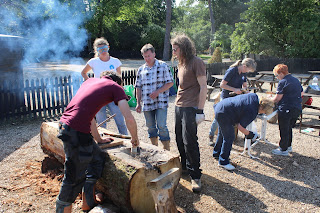All the recent excitement of experimental archaeology and Mesolithic woodworking techniques culminated in a final public event for the year.
 |
| The Mesolithic woodworking team and The Log. |
 Using flint, wood, bone, and antler tools, we started constructing a logboat with Mesolithic techniques. The log was cut from a semi-seasoned oak tree that had been felled at Exbury Gardens. The tree was forked, and since we only had one day to attempt the construction project, the kind folks at Exbury removed the 'fork' to give us a head start. Even so, we may have bitten off more than we could 'hew'!
Using flint, wood, bone, and antler tools, we started constructing a logboat with Mesolithic techniques. The log was cut from a semi-seasoned oak tree that had been felled at Exbury Gardens. The tree was forked, and since we only had one day to attempt the construction project, the kind folks at Exbury removed the 'fork' to give us a head start. Even so, we may have bitten off more than we could 'hew'! |
| Maritime Archaeology Trust's Discovery Bus joined us for the event to better contextualize the underlying maritime nature of what we were attempting to do. |
The logboat-to-be is a smaller-scale version of the oak watercraft suspected to have been constructed at the now-submerged site of Bouldnor Cliff some 8,000 years ago. By re-creating this logboat, we can better understand how our Mesolithic ancestors interacted with their forest resources to adapt to an increasingly marine environment. During this period of rapid climate change, people were becoming more reliant on watercraft for travel -- to move over widening rivers and lakes, and across newly formed seas.
 |
| On the end of the The Log, you can see a patch of rot, which we thought would help us remove wood more efficiently - and with enough time, it would have! |
We are in the planning phase of extending this one-day event into a longer-term, more comprehensive foray into the reality of Mesolithic boatbuilding techniques. For more information, or to see how you can get involved, please let us know!

No comments:
Post a Comment